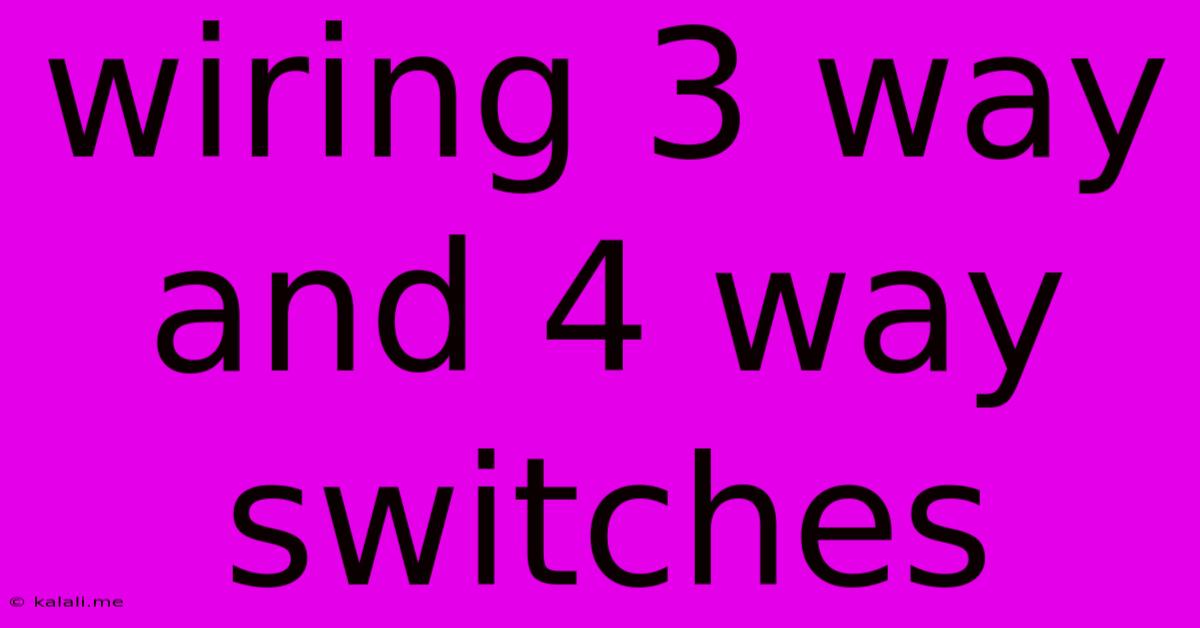Wiring 3 Way And 4 Way Switches
Kalali
Jun 02, 2025 · 4 min read

Table of Contents
Mastering 3-Way and 4-Way Switches: A Comprehensive Guide
Controlling a light fixture from two or more locations requires more than a simple on/off switch. This is where 3-way and 4-way switches come into play. Understanding how to wire these switches correctly is crucial for any DIY home improvement project, offering increased convenience and functionality. This guide will break down the intricacies of both 3-way and 4-way switch wiring, ensuring you're equipped to tackle your next electrical project with confidence.
What are 3-way and 4-way switches? This seemingly simple question is the foundation of understanding the complexities of multi-location lighting control. A 3-way switch allows you to control a light from two different locations. A 4-way switch, on the other hand, is used in conjunction with at least two 3-way switches to control a light from three or more locations. They work together to create a complete circuit.
Understanding the Components
Before diving into the wiring diagrams, let's familiarize ourselves with the components involved:
- 3-Way Switches: These switches have three terminals, usually marked as "Common," "Traveler 1," and "Traveler 2." The common terminal connects to the power source, while the traveler terminals connect to the other switches in the circuit.
- 4-Way Switches: These switches have four terminals: two "common" terminals and two "traveler" terminals. They act as an intermediary, switching the connection between the traveler wires.
- Electrical Box: The enclosure where all wires and switches are safely housed.
- Wiring: Typically, 14/2 or 12/2 gauge Romex cable is used.
Wiring a 3-Way Switch Setup
This configuration controls a light from two separate locations. Here’s a step-by-step guide and visual representation (remember to always turn off power at the breaker before starting any electrical work):
- Power Source: The power cable enters one of the 3-way switch boxes. Connect the black (hot) wire from the power source to the "Common" terminal of one of the 3-way switches.
- Traveler Wires: Connect the remaining two wires (the "Traveler 1" and "Traveler 2") from the first switch to the corresponding "Traveler 1" and "Traveler 2" terminals on the second 3-way switch. These wires carry the signal between the switches.
- Light Fixture: From the "Common" terminal of the second 3-way switch, connect a black (hot) wire to the light fixture.
- Neutral and Ground: Connect the white (neutral) wires together, and the bare copper (ground) wires together in each box. This completes the circuit.
Wiring a 4-Way Switch Setup
Adding a 4-way switch to your circuit allows control from three or more locations. This requires at least two 3-way switches and one or more 4-way switches.
- Power and First 3-Way Switch: This step remains the same as in the 3-way setup. The power enters one electrical box, connecting to the common of a 3-way switch.
- Traveler Wires: The traveler wires from the first 3-way switch connect to the traveler terminals of the first 4-way switch.
- Additional 4-Way and 3-Way Switches (if needed): The traveler wires from the first 4-way switch connect to the traveler terminals of the next 4-way switch or 3-way switch in the series. This continues until you reach the final switch.
- Final 3-Way Switch and Light Fixture: The traveler wires from the last switch in the series connect to the traveler terminals of the final 3-way switch. The common terminal of the final 3-way switch connects to the light fixture.
- Neutral and Ground: As before, connect all neutral and ground wires together within each box.
Important Considerations:
- Always Turn Off the Power: Safety is paramount. Before working with any electrical wiring, turn off the power at the breaker box.
- Color Coding: Consistent color coding is essential to avoid errors. Use black for hot, white for neutral, and bare copper for ground.
- Proper Wiring: Incorrect wiring can lead to malfunction or even fire hazards. If unsure, consult a qualified electrician.
- Switch Types: Ensure you're using the correct type of switch (3-way or 4-way) for your specific needs.
This guide provides a foundational understanding of wiring 3-way and 4-way switches. Remember, electrical work can be dangerous. If you lack experience, it's best to consult a licensed electrician to ensure safe and correct installation. Improper wiring can result in electrical hazards, so prioritize safety above all else.
Latest Posts
Latest Posts
-
Can You Put Eggshells In The Garbage Disposal
Jun 04, 2025
-
How To Keep Refrigerator From Moving
Jun 04, 2025
-
How To Make Decaf Coffee At Home
Jun 04, 2025
-
How To Give Crostini Access To Usb Device Chromebook
Jun 04, 2025
-
Can You Carry Shaving Cream On A Plane
Jun 04, 2025
Related Post
Thank you for visiting our website which covers about Wiring 3 Way And 4 Way Switches . We hope the information provided has been useful to you. Feel free to contact us if you have any questions or need further assistance. See you next time and don't miss to bookmark.